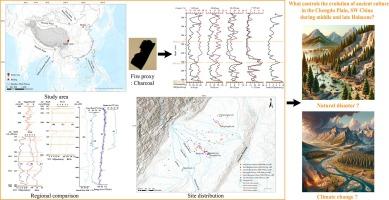Drivers of prehistoric cultural evolution in the Chengdu Plain: Fire events and environmental changes during the middle and late Holocene
IF 7
2区 环境科学与生态学
Q1 ENVIRONMENTAL SCIENCES
引用次数: 0
Abstract
The Chengdu Plain (CDP), located in the upper reaches of the Yangtze River and recognized as one of the cradles of ancient Chinese civilization, is closely associated with the ancient Shu culture. While previous studies have extensively explored the relationship between environmental disasters and cultural evolution in the CDP, the impact of paleofire events remains insufficiently examined. This study provides a comprehensive analysis of charcoal particles across various size (0–30, 30–50, 50–125, and > 125 μm) from sediment samples collected at the Baodun and Majie sites in the CDP. Key findings include: (1) Minimal paleofire activity is evident between 6200 and 5100 cal. a BP, aligning with low levels of human occupation. After 5100 cal. a BP, anthropogenic fire activity notably increased, associated with practices such as slash-and-burn agriculture, pottery production, bronze smelting, ritual activities, warfare, and social conflicts. (2) Large-scale fires corresponded closely with abrupt climatic shifts. An expansion of herbaceous vegetation likely contributed to heightened fire frequencies, particularly of local fires after 4500 cal. a BP, indicating that climatic conditions significantly influenced fire regimes alongside changing vegetation patterns. (3) High charcoal concentrations in the late phases of earlier cultural periods correlate with later settlements located at higher elevations and greater distances from rivers. Shifts in settlement orientation, with eastern-facing settlements showing lower average charcoal concentrations and westward-facing settlements exhibiting increased charcoal deposition, suggest changes in fire exposure related to settlement locating choices. (4) The decline of the Sanxingdui and Jinsha-Shierqiao cultures appears to be primarily driven by natural disasters, rather than solely by climate-induced environmental changes. However, in other periods, a strong correlation between climatic fluctuations and cultural transitions underscores the complex interplay between environmental dynamics and human adaptation strategies.

成都平原史前文化演变的驱动因素:全新世中晚期的火灾事件与环境变化
成都平原(CDP)位于长江上游,是公认的中国古代文明发祥地之一,与古蜀文化密切相关。以往的研究广泛探讨了成都平原环境灾害与文化演化之间的关系,但对古火灾事件的影响研究仍显不足。本研究全面分析了在 CDP 宝墩和马街遗址采集的沉积物样品中不同粒度(0-30、30-50、50-125 和 > 125 μm)的木炭颗粒。主要发现包括(1) 公元前 6200 年至公元前 5100 年期间,古火灾活动极少,这与低水平的人类活动相吻合。公元前 5100 年之后,人为火灾活动明显增加,这与刀耕火种农业、陶器生产、青铜冶炼、祭祀活动、战争和社会冲突等活动有关。(2)大规模火灾与气候的突然转变密切相关。草本植被的扩展很可能导致火灾频率的增加,尤其是公元前 4500 年以后的局部火灾,这表明气候条件在植被模式变化的同时也对火灾机制产生了重大影响。(3) 早期文化时期晚期的木炭浓度较高,这与晚期聚落位于海拔较高、距离河流较远有关。聚落朝向的变化,朝东的聚落平均木炭浓度较低,而朝西的聚落木炭沉积量增加,这表明火灾暴露的变化与聚落选址有关。(4) 三星堆文化和金沙江石儿桥文化的衰落似乎主要是由自然灾害造成的,而不仅仅是由气候引起的环境变化。然而,在其他时期,气候波动与文化变迁之间的密切关联凸显了环境动态与人类适应策略之间复杂的相互作用。
本文章由计算机程序翻译,如有差异,请以英文原文为准。
求助全文
约1分钟内获得全文
求助全文
来源期刊

Ecological Indicators
环境科学-环境科学
CiteScore
11.80
自引率
8.70%
发文量
1163
审稿时长
78 days
期刊介绍:
The ultimate aim of Ecological Indicators is to integrate the monitoring and assessment of ecological and environmental indicators with management practices. The journal provides a forum for the discussion of the applied scientific development and review of traditional indicator approaches as well as for theoretical, modelling and quantitative applications such as index development. Research into the following areas will be published.
• All aspects of ecological and environmental indicators and indices.
• New indicators, and new approaches and methods for indicator development, testing and use.
• Development and modelling of indices, e.g. application of indicator suites across multiple scales and resources.
• Analysis and research of resource, system- and scale-specific indicators.
• Methods for integration of social and other valuation metrics for the production of scientifically rigorous and politically-relevant assessments using indicator-based monitoring and assessment programs.
• How research indicators can be transformed into direct application for management purposes.
• Broader assessment objectives and methods, e.g. biodiversity, biological integrity, and sustainability, through the use of indicators.
• Resource-specific indicators such as landscape, agroecosystems, forests, wetlands, etc.
 求助内容:
求助内容: 应助结果提醒方式:
应助结果提醒方式:


